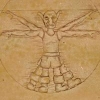Yeah, I know a UV map is flat representation of a 3d model, sort of like a world map is a 3d representation of the world. But who can paint a map of the world using only the geological coordinates of the objects in the world? Sounds like an interesting project, but it is just plain crazy.
The world is not a perfect sphere, but really a messy continuous flow of valleys and hills. So how would I paint a window on the statue of liberty from a 2d representation of the city of New York? Sorta counter-intuitive to say the least.
This stage of the process for making game assets is really getting me, because I don't have a team of people, and I want my textures to be good.
Actually, this would be possible if only the free version of sketchup would let me export my models with the textures correctly displaying in Blender. I can use projection painting for organic models.
So yeah, I am using Sketchup for more hard-surface modeling, and I prefer it too. I looked up a UV plugin for sketchup but couldn't get it to work.
My workflow is Sketchup to Blender to My Game Engine.
But Sketchup to Blender is glitchy (for now) accept if I don't mind my models having that plain white material with ambient occlusion. Blender to My Game Engine is questionable (UV unwrapping is a pain). My Engine doesn't have level design stuff built into it, so everything is imported.
I must find a better solution (don't have the money to spend on Zbrush right now). Any tips, links or tricks for making this UV unwrapping process less frustrating?










